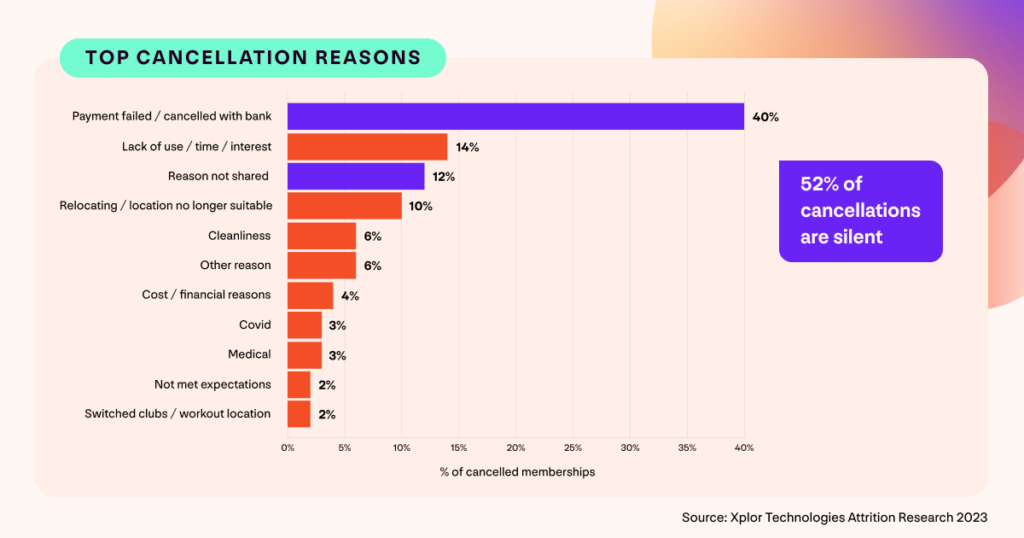How & When To Address Cancellations
Should you try to win back leisure members who cancel? The answer is not straightforward. Working out how to effectively handle cancellations requires careful consideration. There is no one-size-fits-all approach. Learn what to think about and where to start.
If you offer memberships, you will always have some members who choose to cancel – no matter what the size or shape of your leisure organisation. It’s valuable to know why your leisure members cancel and fix what you are able to, so in the future members don’t leave for the same reasons.
In some cases, you may be able to win back some leisure members who’ve cancelled, although, not everyone will want to return. So, it’s essential to take a strategic approach when handling cancellations.
This article explores how to work out what’s best for your leisure organisation and your members.
Choose a targeted approach
The Winning The War On Attrition report at looked the main reasons why members cancel in detail. It found that in most cases, members silently cancel – they don’t tell leisure centres why they are leaving at all. Forty percent cancel indirectly by simply cancelling their Direct Debit or failing to pay for another reason.

Therefore, the first step must be reducing the volume of members who cancel silently (both directly and indirectly). In doing so, your leisure organisation will be able to resolve common issues that result in leisure members leaving. It will also become easier to identify those who show a high risk of cancelling so you can re-engage these members fast.
There are some steps you can take to follow up with leisure members who’ve already cancelled. Choose the actions you take strategically, focusing on the segments where you can best achieve positive results.
Cancellations for these reasons tend to be most actionable:
- Cleanliness
- Lack of use
- No interest or motivation to visit
- Not met member expectations
- Cost & financial reasons
Addressing and winning back leisure members who’ve cancelled
Sometimes it is possible to win back leisure members who have cancelled by asking some carefully worded questions and offering an incentive to return.
In most cases though, you’ll want to learn more from those who have a cancelled membership. This will help you gather learnings that can be applied to reduce the number of members leaving for the same reasons in the future.
Strategic follow up approaches for leavers
The most effective way of following up with members who cancel and leave will differ based on:
- Volume of members who cancel
- Reasons why members leave and cancel
- How your organisation manages feedback
- The technology you have in place
- Your team – both in terms of capacity and skillsets
Start small and scale your follow up approaches based on the results you see.
“Look at the different leave reasons your members give you and decide to focus on a few specific areas.
Make your primary goal to find out more about leavers, to learn from them, so you can reduce leavers next month. The secondary aim is to see if you can recover them.
Outline two or three recovery options that your staff can offer to save a member depending on their reason.
Track success of each option. Then adapt and fine-tune to save more leave requests in the future.”
Guy Griffiths, GGFit
These are some ideas for follow ups that could work for your leisure organisation based on common cancellation reasons highlighted in our attrition research:
Cancellation reason: Not met expectations
The key objective here should be understanding why member expectations haven’t been met. And taking action to fix addressable feedback, so fewer future members leave for the same reasons.
Approach:
- Create a simple survey to send to leisure members who cancelled as their expectations were not met. Send this out via email & SMS
- Tip: If your cancellation reasons provide further insights into why expectations have not been met, you could target specific reasons first with customised surveys. This will let you take a tailored approach and get better insights from a smaller group
- Consider offering an incentive to complete the survey (for example, entry into a prize draw to win a gift card)
- Ask for permission to call and ask more questions (include this as an opt-in question in your survey)
- Review the answers you receive and follow up with any questions (where you have permission to call)
Using the information you gather, work to address the issues raised. To encourage former members back, show what you’ve done to fix issues in a public way using your social media channels, email updates etc.
Cancellation reason: Lack of use, interest, or motivation
Sometimes your leisure members will leave telling you that they failed to get enough use out of their membership investment. Or that they are leaving as they have lost interest or motivation to visit.
When you hear reasons like these, your objective when following up should be to find out if there is anything else you could have done to support them.
Approach:
- Identify if there are particular segments you can prioritise targeting first. For example, look at whether a specific demographic group is most likely to stop visiting soon after joining. Or identify a specific reason, for example if members say they got ‘no enjoyment’ from using their leisure membership
- Having identified and selected a specific segment of this group to follow up with, ask them if there is anything else you could have done to support them. The method you choose to use when getting in touch will depend on what works best for the demographics and size of the group
From time-to-time, you may be able to tempt a member back in with a personal training session or class for free. Record and review the learnings you get from the feedback and apply them for new and existing leisure members.
Cancellation reason: Cost / financial reasons
On average 3.6% of former members cancelled for cost and finance related reasons. With the higher cost of living, this grew to 4.4% in 2022 and early-2023. Additionally, some of the memberships cancelled due to a payment failure may well have been down to cost and financial difficulties.
A careful approach is essential, as cost and finances can be a very sensitive topic. Above all else focus on being supportive, understand if there is any help you can offer to those concerned with cost to encourage them back (now or in the future).
Approach:
- Typically it is best to choose a smaller subset of cancelled members in this group to target:
- Review the insights available in your leisure management software to see past visit patterns
- Where a member has previously visited on a frequent basis (even if that’s 2-4 times a month) they are more likely to return to your leisure centre in the future
- Also look at specific cancellation reasons (if these are available). For example, if you can see cancellations due to loss of earnings you could offer support
- Contact the group you have chosen to target. A phone call is sometimes easiest (providing you have appropriate skillsets in your team). This should be a conversation checking in on them, never a sales call. Depending on the individual circumstances, you could ask questions around value for money received rather than affordability
In some cases, you could offer a membership freeze for a specific period. Or suggest a lower rate or pay-a-you-go option. Focus on showing support and encouraging these cancelled leisure members back in to your facilities gently and when the time is right.
Addressing cancellations
Trying to win back leisure members who have cancelled is challenging and time-consuming. Usually, it is more effective to stop them leaving in the first place.
The Winning The War On Attrition report contains extensive insights and leisure industry expert tips to help you retain more members for longer.
Conclusion
Leisure operators should look to take a strategic approach to handling cancellations by identifying where the biggest impact can be had. Often that means focusing on learning more from those leaving and cancelling, rather than attempting to win back members who’ve cancelled.
The approach you take to following up should be adapted based on the number of members cancelling, exact leaving reasons, the technology you use, and your team. You will require a selection of different follow up processes to suit specific scenarios. Start small by choosing where you can have most impact, and scale your efforts.
Get more insights to help you stop leisure members leaving. Download your complimentary copy of the Winning The War On Attrition report.
* About the research:
The attrition insights featured in this article and the Winning The War On Attrition report are based on Xplor data from 714,674 leisure, health club and gym members paying by Direct Debit in the UK & Ireland.
As well as current members, it includes data on members who held a membership that’s been cancelled between January 2017 and April 2023.
The data was collected in May 2023.



